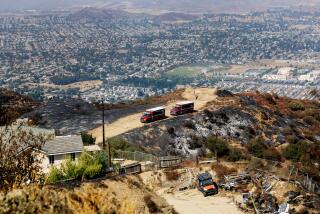Firefighters Tackle Blazes Across West
- Share via
LAS VEGAS — Hard-pressed firefighters from Texas to the Pacific Northwest benefited Tuesday from improved weather in battling 41 large wildfires, but they braced for worsening conditions later in the week.
The blazes had consumed more than 300,000 acres across the West, occupying 18,000 firefighters from a host of federal, state and local agencies.
Even as firefighters encircled some of the largest fires, new ones erupted, including a 500-acre blaze near Ramona in San Diego County that was threatening homes.
Nevada, with its lighter, flash-fuel desert grasses and pinyon pines, was taking the brunt of the fires Tuesday. Of all the acreage burning in the current fires, two-thirds have been charred in the Silver State, afflicted by one of the driest and hottest summers in recent history.
North of Elko, four separate fires had joined together into a single, 40,000-acre blaze near the small gold mining town of Midas, home to about 60 families. The nearest flames were several miles away from them but were approaching a ridgeline overlooking the high-desert hamlet.
“There is the potential of the fire burning into the town,” said Steve Frady, spokesman for the Nevada Division of Forestry.
Firefighters there were having to truck water into the area, Frady said, because the town’s 30,000-gallon water tank was recharging at only 15 gallons a minute.
“We’re drafting water out of creeks and using well water from nearby ranches and mines,” Frady said. “That’s causing a little problem.”
Don Smurthwaite, a fire information officer for the National Interagency Coordination Center in Boise, Idaho, said conditions across much of the region Tuesday were hot and dry, but not as windy as earlier in the week, when most of the fires were ignited by lightning.
On Monday, firefighters had contained 12 fires, but 18 new ones were reported. At least conditions were improving somewhat, Smurthwaite said.
Tuesday and probably today, he said, “are good days to fight fire, and we’re hoping to make substantial progress on the major blazes.”
But despite the slight weather respite, fire bosses were braced for more trouble later in the week, with a forecast of more dry thunderstorms pummeling the West with lightning and driving uncontained fires with erratic winds.
On Tuesday, smoke from a 1,600-acre blaze in the Tahoe National Forest, 20 miles west of Truckee, forced the closure of Interstate 80 between Colfax and the Yuba Pass, east of Sacramento.
Another fire, in California’s Inyo National Forest, had burned more than 5,600 acres by Tuesday evening but was near containment.
In Oregon, a 5,000-acre fire 10 miles southwest of Medford was within a mile of entering California, and the 1,250 firefighters battling it had not been able to establish lines around any of its perimeter.
And near the small eastern Oregon town of Monument, population 150, a fire grew to 4,300 acres Tuesday, mushrooming overnight from just 800 acres Monday. More than a dozen homes were in jeopardy.
In Washington, 20 small, scattered forest fires were burning six miles southwest of Leavenworth, at the base of the Cascade Mountains, frustrating firefighters because of very rugged terrain and limited access.
Also in Washington, a 13,000-acre fire 12 miles south of Okanagan had destroyed nine homes and three other structures, said Nancy Lull, a fire information officer.
Some fires were huge but causing little immediate anxiety.
For instance, the West’s largest fire had burned through 62,900 acres of public land near the small Northern California town of Ravendale, but the blaze was not threatening any structures. By Tuesday, firefighters had encircled about half of it with firebreaks.
A 13,000-acre fire in California’s Mendocino National Forest, four miles west of Stoneyford, also was about half contained by Tuesday night, after having destroyed 10 homes.
In northeastern California, two fires were burning in the Modoc National Forest. A 30,000-acre blaze 13 miles east of Likely prompted the evacuation of residents and campers near Blue Lake and Jess Valley. Forty miles away near Canby, eight smaller fires had burned nearly 5,000 acres.
Firefighters were not without their successes Tuesday.
A 20,000-acre fire 10 miles northeast of Doyle, Calif., near the Nevada state line was 70% contained, with full containment expected by today, thanks to the efforts of 750 firefighters. At one point, 16 homes were threatened, but only five outbuildings were lost.
And a 7,500-acre Nevada blaze that started Sunday 20 miles east of Battle Mountain was fully contained.
But other fires in Nevada continued to march through desert sagebrush, including two fires northwest of Winnemucca that combined as a single, 25,000-acre blaze.
Another fire half that size was burning 11 miles south of Winnemucca, threatening 20 homes, while a 3,000-acre fire 30 miles northeast of Elko was threatening eight homes but was 60% contained.
Frady, of the Nevada Division of Forestry, said he was worried that the onslaught of fires this week will soon be taking its toll on firefighters, who are required to take two days off after 14 days on the fire lines.
“We may be looking at a lot of our resources going on downtime at about the same time,” he said.
Gorman reported from Las Vegas and Hernandez from Los Angeles.
More to Read
Sign up for Essential California
The most important California stories and recommendations in your inbox every morning.
You may occasionally receive promotional content from the Los Angeles Times.













